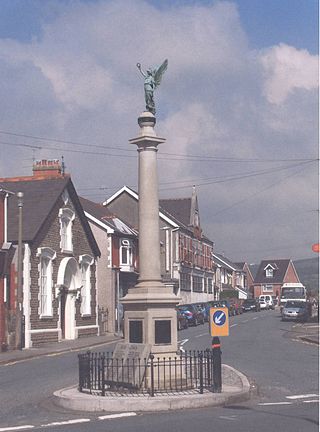
Porthcawl ( ) is a town and community in the Bridgend County Borough of Wales. It is located on the south coast, 25 miles (40 km) west of Cardiff and 19 miles (31 km) south-east of Swansea.

Bridgend County Borough is a county borough in the south-east of Wales. The county borough has a total population of 139,200 people, and contains the town of Bridgend, after which it is named. Its members of the Senedd are Sarah Murphy MS, representing the Bridgend Constituency, and Huw Irranca-Davies MS representing the Ogmore Constituency, and its members of the UK parliament are Chris Bryant, Chris Elmore, and Stephen Kinnock.

Kenfig is a village and former borough in Bridgend, Wales. It is situated 1 mile (1.6 km) inland on the north bank of the Bristol Channel, and just south-west of the M4 motorway. To the east is the town of Bridgend, at approximately 6 miles (10 km), and the capital city of Cardiff, at 24 miles (40 km). To the west lies Port Talbot, at approximately 7 miles, and Swansea at approximately 18 miles.

Bridgend is a constituency represented in the House of Commons of the UK Parliament since 2024 by Chris Elmore of Labour.

Pyle railway station is a minor station in Pyle in Bridgend county borough, south Wales. The station is located at street level at Beach Road in Pyle, 196 miles 40 chains (316.2 km) from the zero point at London Paddington, measured via Stroud.

Aberkenfig is a village located in the County Borough of Bridgend, Wales to the north of Bridgend town. It is in the community of Newcastle Higher.

Culverhouse Cross is a district straddling the boundary between Cardiff and the Vale of Glamorgan, Wales, in the community of Wenvoe.

Cornelly is a community and electoral ward in Bridgend County Borough, South Wales. As of 2011 the population of the Cornelly ward was 7,059.

St Nicholas is a village situated in the Vale of Glamorgan, Wales. It lies 2 miles west of Cardiff and 6 miles east of Cowbridge. According to the 2021 census, the village had a population of 654 residents. St Nicholas forms part of the larger community of St Nicholas and Bonvilston.
North Cornelly is a moderately sized village in Bridgend County Borough, Wales. It is four miles from the seaside resort of Porthcawl and six miles from the town of Bridgend. The Kenfig nature reserve is less than a mile away.
Cynffig was a community in the west of Bridgend County Borough, bordering Neath Port Talbot, Wales. The community included the villages of North Cornelly, South Cornelly, Kenfig and Pyle.
South Cornelly is a village in Cornelly, Bridgend county borough, Wales. The village is close to North Cornelly, Pyle and Porthcawl, and junction 37 of the M4 motorway, which runs along its northern side. It is in the historic county of Glamorgan. The population was 471 in 2011.

Cefn Cribwr is a village and community in Bridgend County Borough in south Wales. The village is located about 5 miles (8 km) from the centre of Bridgend town, and in-between Bridgend and Pyle.

Cynffig/Kenfig is a Site of Special Scientific Interest which includes Kenfig Sands and its sand dunes near Kenfig in Bridgend County Borough, South Wales. The Kenfig National Nature Reserve is also situated at the site and contains the largest lake in Glamorgan, Kenfig Pool.

Kenfig Hill is a village in Bridgend County Borough, South Wales. It is bordered by Pyle to the south-west, Cefn Cribwr to the north-east, North Cornelly to the south and Moel Ton-Mawr mountain to the north.

The South Wales Coast and Severn Estuary Coastal Path covers Region H of the larger Wales Coast Path, an 870-mile (1,400 km) long-distance walking route around the whole coast of Wales which opened on 5 May 2012. The South Wales Coast and Severn Estuary stretch is a 109-mile (176 km) in length running from Kenfig Dunes near Port Talbot, South Wales to Chepstow. With five local councils involved in its creation and maintenance, the route goes through a heritage coast, three national nature reserves and three heritage landscapes.
Kenfig is a village and former borough in Bridgend, Wales.

Sarah Murphy is a Welsh Labour and Co-operative politician, serving as Minister for Mental Health and Wellbeing since July 2024.



















